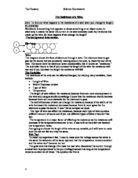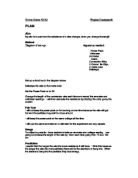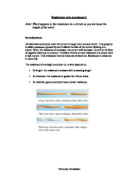Length of wire increases the resistance because the electrons have further to move and more collisions occur. So, if you double the length of wire, you double the resistance. Because the number of atoms and the number of collisions doubles.
Type of wire affects resistance because different types have different atom arrangements. Some have different patterns, and some are arranged so that electrons have an easier path to travel through the atoms.
Fair Test.
To make the experiment fair, I will make sure that the temperature stays the same flowing through the power pack and wire. I will do this by turning it off and recording my results quickly.
In addition, I will make sure that the thickness and the type of wire are the same. I will only change the length of the wire.
Prediction.
I predict that the resistance will increase because the length of wire has increased. This means, that the electrons have further to travel and collide with atoms more. I predict that if you double the length of wire, you will double the resistance also because the number of atoms and the number of collisions doubles.
Safety.
To make sure that this experiment is safe, I will use a low voltage and check the readings quickly. This will stop the wire from melting or over heating. As I will turn the power pack off quickly. In addition, if I use a water bath I will keep the crocodile clips out of the water.
Method.
I will use different lengths of copper wire (10,20,30,40,50 as shown in my preliminary work,) and attach them to a power pack, a voltmeter and an ammeter using crocodile clips. I will use one length of wire at a time. When I turn the power on, I will record the current and voltage quickly to 2d.p for accuracy.
Then I will work out the resistance using Ohms Law:
I will do this for all five measurements. I am using these measurements because my preliminary work gave me a good result when I tested them. I will repeat the tests three times to make sure that I get an reliable result. This way my results will be reliable.
Results.
Analysis.
My table and graph show that the longer the wire the more resistance there is. For example, 10cm = 17.5 resistance and 50cm = 21.5 resistance. This is because the number of collisions increases between the atoms and the electrons. This tells me that if I use a wire that was 60cm long it would have a higher resistance. This does agree with my prediction. Although, there are two lengths that were very odd. They are circled on the graph. I think I read the readings wrong. Even though it didn’t get a doubling effect, because the resistance was higher than I expected and this changed my results, I did get enough evidence to say that the resistance increases when you increase the length. My prediction shows that my length of wire should double, but my results do not show this.
Evaluation.
It was not easy to get the exact measurements because some were a couple of mm off.
As you can see the crocodile clips made it hard to get the exact measurements.
It was not easy to keep a constant temperature, we had to take the readings quickly. This is because the wire can get hot very quickly. I could have had bigger lengths or put the wire in a water bath. However, I would have had to make sure that the crocodile clips did not go into the water for safety. Two of my results did not fit the pattern. I believe that this was because of the temperature of the wires as I have said above. Also, the resistance didn’t double when I doubled the length of wire, this could be because the atom arrangement in copper wire makes it very easy for electrons to slip through unnoticed as it is a very good conductor. I could change this by increasing the length of the wire or keep lengths the same as before but use a different type of wire. My graph shows this. I have realised that the readings must have been wrong, but I would retest them. To make my results more accurate, I would repeat the experiment. I have enough evidence to reach a conclusion. My results match what other people have found. To additional evidence, I would do another experiment using the same measurements but different types of wire e.g. constaintin. I would do this because I could see if the two odd results became more accurate and because it is known to have a higher resistance than copper wire. To extend my investigation I could use lengths of wire over 50cm. Or, to test my work, I would use a different type of wire. This would change my results because every different types of wire have their own arrangement of atoms (obstacle course).







